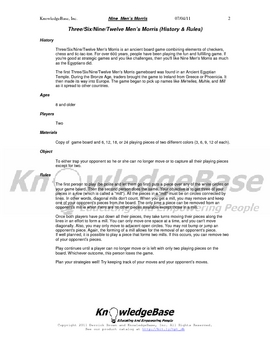
An ideal position, which typically results in a win, allows a player to shuttle one piece back and forth between two mills, removing a piece every turn. Flying was introduced to compensate when the weaker side is one man away from losing the game.Īt the beginning of the game, it is more important to place pieces in versatile locations rather than to try to form mills immediately and make the mistake of concentrating one's pieces in one area of the board.
INSTRUCTIONS FOR NINE MENS MORRIS MANUAL
A 19th-century games manual calls this the "truly rustic mode of playing the game". Some rules sources say this is the way the game is played, some treat it as a variation, and some do not mention it at all. When a player is reduced to three pieces, there is no longer a limitation on that player of moving to only adjacent points: The player's men may "fly" (or "hop", or "jump" ) from any point to any vacant point. When one player has been reduced to three men, phase three begins. The act of removing an opponent's man is sometimes called "pounding" the opponent. A player can "break" a mill by moving one of his pieces out of an existing mill, then moving it back to form the same mill a second time (or any number of times), each time removing one of his opponent's men. Players continue to try to form mills and remove their opponent's pieces as in phase one. Players continue to alternate moves, this time moving a man to an adjacent point. After all men have been placed, phase two begins. If a player is able to place three of their pieces on contiguous points in a straight line, vertically or horizontally, they have formed a mill and may remove one of their opponent's pieces from the board and the game, with the caveat that a piece in an opponent's mill can only be removed if no other pieces are available. The players determine who plays first, then take turns placing their men one per play on empty points. Nine men's morris starts on an empty board.


A player wins by reducing the opponent to two pieces (where they could no longer form mills and thus be unable to win), or by leaving them without a legal move. Players try to form 'mills'-three of their own men lined horizontally or vertically-allowing a player to remove an opponent's man from the game. Each player has nine pieces, or "men", usually coloured black and white. The board consists of a grid with twenty-four intersections or points.

Three main alternative variations of the game are three, six, and twelve men's morris. The Latin word merellus means 'gamepiece', which may have been corrupted in English to 'morris', while miles is Latin for soldier. It has been shown that with perfect play from both players, the game results in a draw. Nine men's morris is a solved game, that is, a game whose optimal strategy has been calculated. The game has also been called cowboy checkers and is sometimes printed on the back of checkerboards. The game is also known as nine-man morris, mill, mills, the mill game, merels, merrills, merelles, marelles, morelles, and ninepenny marl in English. The shade of leather may differ from the one show in the picture.Nine men's Morris is a strategy board game for two players dating at least to the Roman Empire. All pieces are hand-made, the board is burned on the leather.

leather board of 12 x 12 cm (22 cm diameter)Īfter the game, the board turns into a bag for pawns. The game ends when one player has only two pawns left or they cannot do a permitted movement (all adjacent fields are occupied). If player manages to do it, he can remove one opponent's pawn from the board. The game's aim is to put the players' nine pawns in turns onto the board and then moving them to adjacent fields to put three of them in a line. The highest popularity of the game fell on the Middle Ages and it's probably the game about which Shakespeare mentions in "A Midsummer Night's Dream". It is impossible to follow its origins or places of occurrence, but a similar game called sam-ki or luk-tsut-ki was described by Confucius (551-479 BC). Currently, Nine Men's Morris has many variations. The first miniatures of the board are found in graves from the Bronze Age (ca. Nine Men's Morris is a game for two people, known all over the world for a very long time.


 0 kommentar(er)
0 kommentar(er)
